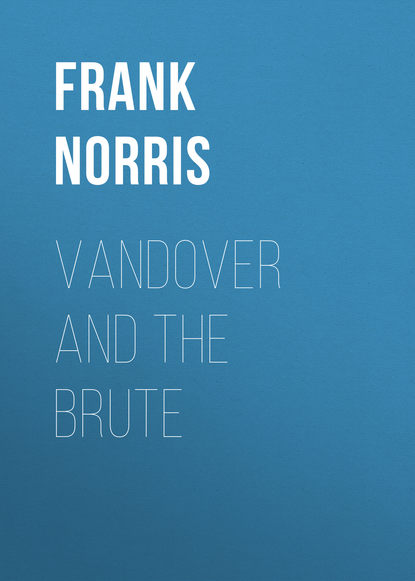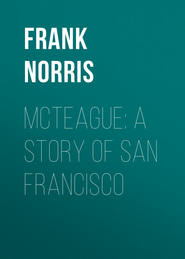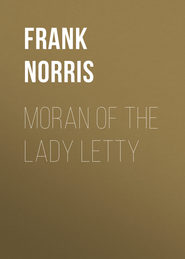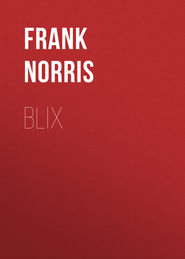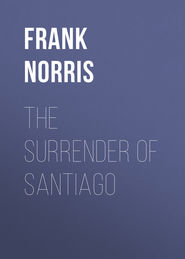По всем вопросам обращайтесь на: info@litportal.ru
(©) 2003-2024.
✖
Vandover and the Brute
Настройки чтения
Размер шрифта
Высота строк
Поля
The three locked arms and started slowly toward the Turkish baths. On their way they stopped at an all-night drug store and had some seltzer.
Vandover had about three hours' sleep that night. He was awakened by the attendant shaking his arm and crying:
"Half-past six, sir."
"Huh!" he exclaimed, starting up. "What about half-past six? I don't want to get up."
"Told me to call you, sir, at half-past six; quarter to seven now."
"Oh, all right, very well," answered Vandover. He turned away his face on the pillow, while a wretched feeling of nausea crept over him; every movement of his head made it ache to bursting. Behind his temples the blood throbbed and pumped like the knocking of hammers. His mouth would have been dry but for a thick slime that filled it and that tasted of oil. He felt weak, his hands trembled, his forehead was cold and seemed wet and sticky.
He could recall hardly anything of the previous night. He remembered, however, of going to the Imperial and of seeing Flossie, and he did remember at last of leaving word to be called at half-past six.
He got up without waking the other two fellows and took a plunge in the cold tank, dressed very slowly, and went out. The stores were all closed, the streets were almost deserted. He walked to the nearest uptown car-line and took an outside seat, feeling better and steadier for every moment of the sharp morning air.
Van Ness Avenue was very still. It was about half-past seven. The curtains were down in all the houses; here and there a servant could be seen washing down the front steps. In the vestibules of some of the smaller houses were loaves of French bread and glass jars of cream, while near them lay the damp twisted roll of the morning's paper. There was everywhere a great chittering of sparrows, and the cable-cars, as yet empty, trundled down the cross streets, the conductors cleaning the windows and metal work. From far down at one end of the avenue came the bells of the Catholic Cathedral ringing for early mass; and a respectable-looking second girl hurried past him carrying her prayer-book. At the other end of the avenue was a blue vista of the bay, the great bulk of Mount Tamalpais rearing itself out of the water like a waking lion.
In front of the little church Turner was waiting for him. She was dressed very prettily and the cold morning air had given her a fine colour.
"You don't look more than half awake," she said, as Vandover came up. "It was awfully good of you to come. Oh, Van, you look dreadfully. It is too bad to make you get up so early."
"No, no," protested Vandover. "I was only too glad to come. I didn't sleep well last night. I hope I haven't kept you waiting."
"I've only just come," answered Turner. "But I think it is time to go in."
The little organ was muttering softly to itself as they entered. It was very still otherwise. The morning sun struck through the stained windows and made pretty lights about the altar; besides themselves there were some half dozen other worshippers. The little organ ceased with a long droning sigh, and the minister in his white robes turned about, facing his auditors, and in the midst of a great silence opened the communion service with the words: "Ye who do truly and earnestly repent you of your sins and are in love and charity with your neighbours—"
As Vandover rose with the rest the blood rushed to his head and a feeling of nausea and exhaustion, the dregs of his previous night's debauch, came over him again for a moment, so that he took hold of the back of the pew in front of him to steady himself.
Chapter Five
In the afternoons Vandover worked in his studio, which was on Sacramento Street, but in the mornings he was accustomed to study in the life-class at the School of Design.
This was on California Street over the Market, an immense room partitioned by enormous wooden screens into alcoves, where the still-life classes worked, painting carrots, grapes, and dusty brown stone-jugs.
All about were a multitude of casts, the fighting gladiator, the discobulus, the Venus of Milo, and hundreds of smaller pieces, masks, torsos, and the heads of the Parthenon horses. Flattened paint-tubes and broken bits of charcoal littered the floor and cluttered the chairs and shelves. A strong odour of turpentine and fixative was in the air, mingled with the stronger odours of linseed oil and sour, stale French bread.
Every afternoon a portrait class of some thirty-odd assembled in one of the larger alcoves near the door. Several of the well-known street characters of the city had posed for this class, and at one time Father Elphick, the white-haired, bare-headed vegetarian, with his crooked stick and white clothes, had sat to it for his head.
Vandover was probably the most promising member of the school. His style was sketchy, conscientious, and full of strength and decision. He worked in large lines, broad surfaces and masses of light or shade. His colour was good, running to purples, reds, and admirable greens, full of bitumen and raw sienna.
Though he had no idea of composition, he was clever enough to acknowledge it. His finished pictures were broad reaches of landscape, deserts, shores, and moors in which he placed solitary figures of men or animals in a way that was very effective—as, for instance, a great strip of shore and in the foreground the body of a drowned sailor; a lion drinking in the midst of an immense Sahara; or, one that he called "The Remnant of an Army," a dying war horse wandering on an empty plain, the saddle turned under his belly, his mane and tail snarled with burrs.
Some time before there had come to him the idea for a great picture. It was to be his first masterpiece, his salon picture when he should get to Paris. A British cavalryman and his horse, both dying of thirst and wounds, were to be lost on a Soudanese desert, and in the middle distance on a ridge of sand a lion should be drawing in upon them, crouched on his belly, his tail stiff, his lower jaw hanging. The melodrama of the old English "Home Book of Art" still influenced Vandover. He was in love with this idea for a picture and had determined to call it "The Last Enemy." The effects he wished to produce were isolation and intense heat; as to the soldier, he was as yet undecided whether to represent him facing death resignedly, calmly, or grasping the barrel of his useless rifle, determined to fight to the last.
Vandover loved to paint and to draw. He was perfectly contented when his picture was "coming right," and when he felt sure he was doing good work. He often did better than he thought he would, but never so well as he thought he could.
However, it bored him to work very hard, and when he did not enjoy his work he stopped it at once. He would tell himself on these occasions that one had to be in the mood and that he should wait for the inspiration, although he knew very well how absurd such excuses were, how false and how pernicious.
That certain little weakness of Vandover's character, his self-indulgence, had brought him to such a point that he thought he had to be amused. If his painting amused him, very good; if not, he found something else that would.
On the following Monday as he worked in the life-class, Vandover was thinking, or, rather, trying not to think, of what he had done the Sunday morning previous when he had gone to communion with Turner Ravis. For a long time he evaded the thought because he knew that if he allowed it to come into his mind it would worry and harass him. But by and by the effort of dodging the enemy became itself too disagreeable, so he gave it up and allowed himself to look the matter squarely in the face.
Ah, yes; it was an ugly thing he had done there, a really awful thing. He must have been still drunk when he had knelt in the chancel. Vandover shuddered as he thought of this, and told himself that one could hardly commit a worse sacrilege, and that some time he would surely be called to account for it. But here he checked himself suddenly, not daring to go further. One would have no peace of mind left if one went on brooding over such things in this fashion. He realized the enormity of what he had done. He had tried to be sorry for it. It was perhaps the worst thing he had ever done, but now he had reached the lowest point. He would take care never to do such a thing again. After this he would be better.
But this was not so. Unconsciously, Vandover had shut a door behind him; he would never again be exactly the same, and the keeping of his appointment with Turner Ravis that Sunday morning was, as it were, a long step onward in his progress of ruin and pollution.
He shook himself as though relieving his shoulders of a weight. The model in the life-class had just been posed for the week, and the others had begun work. The model for that week was a woman, a fact that pleased Vandover, for he drew these nude women better than any one in the school, perhaps better than any one in the city. Portrait work and the power to catch subtle intellectual distinctions in a face were sometimes beyond him, but his feeling for the flesh, and for the movement and character of a pose, was admirable.
He set himself to work. Holding his stick of charcoal toward the model at arm's-length, he measured off the heads, five in all, and laid off an equal number of spaces upon his paper. After this, by aid of his mirror, he studied the general character of the pose for nearly half an hour. Then, with a few strokes of his charcoal he laid off his larger construction lines with a freedom and a precision that were excellent. Upon these lines he made a second drawing a little more detailed, though as yet everything was blocked in, angularly and roughly. Then, putting a thin flat edge upon his charcoal, he started the careful and finished outline.
By the end of an hour the first sketch of his drawing was complete. It was astonishingly good, vigorous and solid; better than all, it had that feeling for form that makes just the difference between the amateur and the genuine artist.
By this time Vandover's interest began to flag. Four times he had drawn and redrawn the articulation of the model's left shoulder. As she stood, turned sideways to him, one hand on her hip, the deltoid muscle was at once contracted and foreshortened. It was a difficult bit of anatomy to draw. Vandover was annoyed at his ill success—such close attention and continued effort wearied him a little—the room was overheated and close, and the gas stove, which was placed near the throne to warm the model, leaked and filled the room with a nasty brassy smell. Vandover remembered that the previous week he had been looking over some old bound copies of l'Art in the Mechanics Library and had found them of absorbing interest. There was a pleasant corner and a huge comfortable chair near where they were in the reading-room, and from the window one could occasionally look out upon the street. It was a quiet spot, and he would not be disturbed all the morning. The idea was so attractive that he put away his portfolio and drawing things and went out.
For an hour he gave himself up to the enjoyment of l'Art, excusing his indolence by telling himself that it was all in his profession and was not time lost. A reproduction of a picture by Gérome gave him some suggestions for the "Last Enemy," which he noted very carefully.
He was interrupted by a rustle of starched skirts and a voice that said:
"Why, hello, Van!"
He looked up quickly to see a young girl of about twenty dressed in a black close-fitting bolero jacket of imitation astrakhan with big leg-of-mutton sleeves, a striped silk skirt, and a very broad hat tilted to one side. Her hair was very blond, though coarse and dry from being bleached, and a little flat curl of it lay very low on her forehead. She was marvellously pretty. Vandover was delighted.
"Why, Ida!" he exclaimed, holding her hand; "it's awfully nice to see you here; won't you sit down?" and he pushed his chair toward her.
But Ida Wade said no, she had just come in after a new book, and of course it had to be out. But where had he kept himself so long? That was the way he threw off on her; ah, yes, he was going with Miss Ravis now and wouldn't look at any one else.
Vandover protested against this, and Ida Wade went on to ask him why he couldn't come up to call on her that very night, adding:
"We might go to the Tivoli or somewhere." All at once she interrupted herself, laughing, "Oh, I heard all about you the other night. 'Cherries are ripe!' You and the boys painted the town red, didn't you? Ah, Van, I'm right on to you!"
She would not tell him how she heard, but took herself off, laughing and reminding him to come up early.
Ida Wade belonged to a certain type of young girl that was very common in the city. She was what men, among each other, called "gay," though that was the worst that could be said of her. She was virtuous, but the very fact that it was necessary to say so was enough to cause the statement to be doubted. When she was younger and had been a pupil at the Girls' High School, she had known and had even been the companion of such girls as Turner Ravis and Henrietta Vance, but since that time girls of that class had ignored her. Now, almost all of her acquaintances were men, and to half of these she had never been introduced. They had managed to get acquainted with her on Kearney Street, at theatres, at the Mechanics' Fair, and at baseball games. She loved to have a "gay" time, which for her meant to drink California champagne, to smoke cigarettes, and to kick at the chandelier. She was still virtuous and meant to stay so; there was nothing vicious about her, and she was as far removed from Flossie's class as from that of Turner Ravis.
She was very clever; half of her acquaintances, even the men, did not know how very "gay" she was. Only those—like Vandover—who knew her best, knew her for what she was, for Ida was morbidly careful of appearances, and as jealous of her reputation as only fast girls are.
Bessie Laguna was her counterpart. Bessie was "the girl she went with," just as Henrietta Vance was Turner's "chum" and Nannie was Flossie's "running-mate."
Ida lived with her people on Golden Gate Avenue not far from Larkin Street. Her father had a three-fourths interest in a carpet-cleaning establishment on Howard Street, and her mother gave lessons in painting on china and on velvet. Ida had just been graduated from the normal school, and often substituted at various kindergartens in the city. She hoped soon to get a permanent place.
Vandover arrived at Ida's house that night at about eight o'clock in the midst of a drenching fog. The parlour and front room on the second floor were furnished with bay windows decorated with some meaningless sort of millwork. The front door stood at the right of the parlour windows. Two Corinthian pillars on either side of the vestibule supported a balcony; these pillars had iron capitals which were painted to imitate the wood of the house, which in its turn was painted to imitate stone. The house was but two stories high, and the roof was topped with an iron cresting. There was a microscopical front yard in which one saw a tiny gravel walk, two steps long, that led to a door under the front steps, where the gas-meter was kept. A few dusty and straggling calla-lilies grew about.
Ida opened the door for Vandover almost as soon as he rang, and pulled him into the entry, exclaiming: "Come in out of the wet, as the whale said to Jonah. Isn't it a nasty night?" Vandover noticed as he came in that the house smelt of upholstery, cooking, and turpentine. He did not take off his overcoat, but went with her into the parlour.
The parlour was a little room with tinted plaster walls shut off from the "back-parlour" by sliding doors. A ply carpet covered the floor, a cheap piano stood across one corner of the room, and a greenish sofa across another. The mantelpiece was of white marble with gray spots; on one side of it stood an Alaskan "grass basket" full of photographs, and on the other an inverted section of a sewer-pipe painted with daisies and full of gilded cat-tails tied with a blue ribbon. Near the piano straddled a huge easel of imitation brass up-holding the crayon picture of Ida's baby sister enlarged from a photograph. Across one corner of this picture was a yellow "drape." There were a great many of these "drapes" all about the room, hanging over the corners of the chairs, upon an edge of the mantelpiece, and even twisted about the chandelier. In the exact middle of the mantelpiece itself was the clock, one of the chief ornaments of the room, almost the first thing one saw upon entering; it was a round-faced timepiece perversely set in one corner of an immense red plush palette; the palette itself was tilted to one side, and was upheld by an easel of twisted brass wire. Out of the thumb-hole stuck half a dozen brushes wired together in a round bunch and covered with gilt paint. The clock never was wound. It went so fast that it was useless as a timepiece. Over it, however, hung a large and striking picture, a species of cheap photogravure, a lion lying in his cage, looking mildly at the spectator over his shoulder. In front of the picture were real iron bars, with real straw tucked in behind them.
Ida sat down on the piano stool, twisting back and forth, leaning her elbows on the keys.





